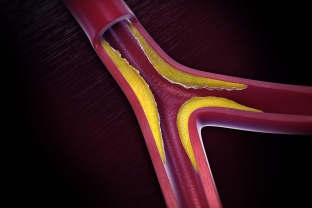Vascular atherosclerosis – dangerous chronic disease. It has not yet been possible to establish the exact causes of the deposition of cholesterol plaques, narrowing of the lumen of the arteries and their loss of elasticity. There are several main theories of the development of atherosclerosis – lipid, parasitic, etc., but today this issue still remains open. But the opinions of doctors agree that there are a number of factors contributing to the development of atherosclerosis. At the same time, some of them can be neutralized by a person in order to reduce the risk of dangerous complications of this disease.
Unremovable factors associated with the development of atherosclerosis
Factors contributing to the development of atherosclerosis are divided into three groups: removable, non-removable, potentially or partially removable.
Unrecoverable Factors:
- Age. With age, the risk of developing this disease increases.
- Gender Atherosclerosis is more common in men than in women and develops about 10 years earlier: in women – after 55 years, in men – after 45 years.
- Genetic predisposition. Early development of atherosclerosis (before 50 years) is most often observed in patients whose relatives also suffered from this disease.
Since heredity, age and gender cannot be changed by a person, these factors in the development of atherosclerosis are classified as unremovable. However, their presence does not mean that you are necessarily at risk of atherosclerosis, because there are also factors that we can influence through lifestyle changes or treatment. These include:
- potentially or partially removable;
- removable.
Potentially or partially eliminated factors influencing the development of atherosclerosis
The group of potentially or partially removable factors includes factors that can be neutralized through timely and adequate treatment, i.e. various diseases and disorders:
- arterial hypertension (high blood pressure contributes to the penetration of fats into the walls of blood vessels, resulting in the formation of an atherosclerotic plaque; while a decrease in the elasticity of blood vessels leads to an increase in pressure);
- fat metabolism disorders (increased levels of cholesterol, LDL, triglycerides in the blood contribute to the formation of plaques);
- obesity and diabetes (since these diseases are also characterized by impaired fat metabolism, they significantly increase the risk of developing atherosclerosis – by 5– 7 times);
- infection and intoxication (may lead to damage to the walls of blood vessels, resulting in an increased risk of atherosclerosis).
Timely treatment of diseases can reduce the risk of atherosclerosis.
Therefore, it is very important to be able to recognize the potential symptoms of the above diseases in order to promptly seek help from a qualified specialist and prevent the occurrence of dangerous complications, including atherosclerosis.

Removable factors contributing to the development of atherosclerosis
The third group of factors contributing to the development of atherosclerosis includes the features of a person's lifestyle, which can subsequently adversely affect the state of his cardiovascular system. All these factors are well known to us, because they are associated with many diseases, in addition to atherosclerosis:
- Smoking. It's no secret that smoking – a bad habit that is fraught with damage to the walls of the arteries, an increased risk of blood clots, as well as problems with the delivery of oxygen to the vital organs of the body. Therefore, estet-portal.com recommends to stop smoking.
- Wrong diet. Balanced diet – an important condition for maintaining a healthy weight, maintaining youth and health, including the heart and blood vessels. If your diet is dominated by animal fats, fried foods and high carbohydrate foods, it's time to rethink it. It is best to work with a nutritionist to determine the best nutritional plan for your body based on your age, health status and level of physical activity.
Read also: Diet for vascular atherosclerosis: healthy foods
- Alcohol. Alcohol abuse leads to increased blood pressure and cholesterol levels, which are factors that increase the risk of atherosclerosis.
- Inactivity. Lack of physical activity alone does not lead to the development of atherosclerosis, however, lack of exercise over time leads to a deterioration in the functioning of the body and can contribute to the development of obesity, high cholesterol and blood pressure.
An active lifestyle, a balanced diet and a rejection of bad habits – main strategy for reducing the risk of developing atherosclerosis.
Taking into account the above, we can conclude that it is impossible to completely eliminate the risk of developing atherosclerosis, but you can minimize it. To do this, you need to adjust the diet, make a choice in favor of active pastime, give up bad habits and start treating diseases in a timely manner. It is especially important to take such measures in the presence of unremovable factors that can provoke the development of atherosclerosis.






Add a comment